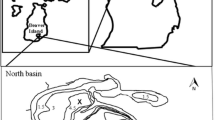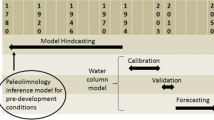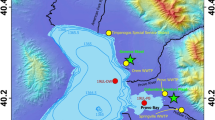Abstract
The potential for atmospheric deposition of sulfur and nitrogen to affect lakes in the Northwestern USA to cause lake acidification was assessed by examining four lakes extending from southern Oregon into the central Washington Cascades. The four lakes were dilute (conductivity 2.2 to 3.6 μS/cm), low ANC (−3 to 11 μeq/L) systems, located in subalpine to alpine settings in designated wilderness areas. The four lakes were cored, dated with 210Pb and 14C, and analyzed for sediment nutrients and diatom remains. Diatom-inferred changes in chemistry were made possible through an earlier project to create a diatom calibration set for the Cascades. The three southern lakes exhibited volcanic inputs of ash or tephra, but diatom stratigraphy generally showed only modest responses to these events. None of the lakes exhibited any recent trends in diatom-inferred pH. The most significant finding with respect to paleolimnology was that Foehn Lake, WA, was formed in the twentieth century (1930 ± 7 years), likely as a result of melting of an adjacent snowfield. Current deposition was estimated using the AIRPACT-3 system, and lake chemistry was simulated using the CE-QUAL-W2 hydrodynamic model that had been modified to represent acid-base chemistry. The model simulations showed that the three southern lakes in the transect were insensitive to increases of nitrogen and sulfur until simulated increases reached 300% of current levels. Foehn Lake showed simulated declines of pH and ANC beginning at 50% increases over current deposition of S and N. The three southern lakes are resistant to changes from atmospheric deposition and other disturbances because of long hydraulic residence times, allowing internal processes to neutralize acidic inputs.






Similar content being viewed by others
References
Arnett, H.A., Soros, J.E., & Mast, M.A. (2012). A caveat regarding diatom-inferred nitrogen concentrations in oligotrophic lakes. Journal of Paleolimnology, 47, 277–291
Bajracharya, S., & Mool, P. (2010). Glaciers, glacial lakes and glacial lake outburst floods in the Mount Everest region, Nepal. Annals of Glaciology, 50, 81–86.
Baker, L. A., Pollman, C. D., & Eilers, J. M. (1988). Alkalinity regulation in softwater Florida lakes. Water Resources Research, 24, 1069.
Baron, J. S., Rueth, H. M., Wolfe, A. M., Nydick, K. R., Allstott, E. J., Minear, J. T., & Moraska, B. (2000). Ecosystem responses to nitrogen deposition in the Colorado Front Range. Ecosystems, 3, 352–368.
Bergstrom, A. K., & Jansson, M. (2006). Atmospheric nitrogen deposition has caused nitrogen enrichment and eutrophication of lakes in the northern hemisphere. Global Change Biology, 12, 635–643.
Blett, T. F., Lynch, J. A., Pardo, L. H., Huber, C., Haeuber, R., & Pouyat, R. (2014). FOCUS: a pilot study for national-scale critical loads development in the United States. Environmental Science & Technology, 38, 225–236.
Chen, J., Vaughan, J., Avise, J., O’Neill, S., & Lamb, B. (2008). Enhancement and evaluation of the AIRPACT ozone and PM2.5 forecast system for the Pacific Northwest. Journal of Geophysical Research, 113, D14305.
Clow, D.W., Streigel, R.G., Nanus, L., Mast, M.A., Campbell, D.H., Krabbenhoft, D.P. (2002). Chemistry of selected high-elevation lakes in seven national parks in the western United States. Water, Air & Soil Pollution: Focus, 139–164.
Clymo, R. S. (1967). Control of cation concentration, and in particular of pH, in Sphagnum dominated communities. In J. S. Golterman & R. S. Clymo (Eds.), Chemical environment in the aquatic habitat. Amsterdam: N.V. Noord-Hollandsche Uitgevers Maatschappij.
Cornett, R. J., Chant, L. A., & Link, D. (1984). Sedimentation of 210Pb in Laurentian Shield lakes. Water Pollution Journal of Canada, 19, 97–109.
Eilers, J. M., Bernert, J. A., Dixit, S. S., Gubala, C. P., & Sweets, P. R. (1996). Processes influencing water quality in a subalpine Cascade mountain lake. Northwest Science, 70, 59–70.
Eilers, J.M., Gubala, C.P., Sweets, P.R., Vache, K.B. (1998). Limnology of Summit Lake, Washington, its acid-base chemistry and paleolimnology. Report to the USDA-Forest Service. 60 pp. + appendices.
Fenn, M. E., Ross, C. S., Schilling, S. L., Baccus, W. D., Larrabee, M. A., & Lofgren, R. A. (2013). Atmospheric deposition of nitrogen and sulfur and preferential canopy consumption of nitrate in forests of the Pacific Nowthwest, USA. Forest Ecology and Management, 302, 240–253.
Fernandez, P., Rose, N. L., Vilanova, R. M., & Grimalt, J. O. (2002). Spatial and temporal comparison of polycyclic aromatic hydrocarbons and spheroidal carbonaceous particles in remote European lakes. Water, Air & Soil Pollution: Focus, 2, 261–274.
Glew, J. R. (1991). Miniature gravity corer for recovering short sediment cores. Journal of Paleolimnology, 5, 285–287.
Glime, J. M., Wetzel, R. G., & Kennedy, B. J. (1982). The effects of bryophytes on succession from alkaline marsh to Sphagnum bog. American Midland Naturalist, 108, 209–223.
Heit, M., Tan, Y. L., Klusek, C., & Burke, J. D. (1981). Anthropogenic trace elements and polycyclic aromatic hydrocarbon levels in sediment cores from two lakes in the Adirondack acid lake region. Water, Air & Soil Pollution, 15, 441–464.
Henriksen, A., & Posch, M. (2001). Steady-state models for calculating critical loads of acidity for surface waters. Water, Air & Soil Pollution: Focus, 1, 375–398.
Henriksen, A., Kamari, J., Posch, M., & Wilander, A. (1992). Critical loads of acidity: Nordic surface waters. Ambio, 21, 356–363.
Kats, L. B., & Ferrer, R. P. (2003). Alien predators and amphibian declines: review of two decades of science and the transition to conservation. Diversity and Distributions, 9, 99–110.
Koinig, K. A., Schmidt, R., Sommaruga-wogath, S., Tessadri, R., & Psenner, R. (1998). Climate change as the primary cause for pH shifts in a high alpine lake. Water, Air & Soil Pollution, 104, 167–180.
Krabbenhoft, D. P., Olson, M. L., Dewild, J. F., Clow, D. W., Streigel, R. G., Dornblaser, M. M., & Vanmetre, P. (2002). Mercury loading and methylmercury production and cycling in high-altitude lakes from the western United States. Water, Air & Soil Pollution: Focus, 2, 233–249.
Lelyveld, M. (2016). China’s coal-fired power plant glut grows. Radio Free Asia (http://www.rfa.org/english/commentaries/energy_watch/china-coal-fired-power-glut-grows-08012016105217.html).
Mote, P. W. (2003). Trends in temperature and precipitation in the Pacific Northwest during the twentieth century. Northwest Science, 77, 271–282.
Mote, P. W., Parson, E. A., Hamlet, A. F., Ideker, K. N., Keeton, W. S., Lettenmaier, D. P., Mantua, N. J., Miles, E. L., Peterson, D. W., Peterson, D. L., Slaughter, R., & Snover, A. K. (2003). Preparing for climatic change: the water, salmon, and forests of the Pacific Northwest. Climatic Change, 61, 45–88.
Mullineaux, D. R. (1974). Pumice and other pyroclastic deposits in Mount Rainier National Park. Washington: U.S. Govt. Print. Off.. Bulletin 1326.
Nelson, P. O. (1991). Cascade mountains. In D. F. Charles (Ed.), Acidic deposition and aquatic ecosystems: regional case studies (pp. 531–563). New York: Springer.
Saros, J. E., Michel, T. J., Interlandi, S. J., & Wolfe, A. P. (2005). Resource requirements of Asterionella formosa and Fragilaria crotonensis in oligotrophic alpine lakes: implications for recent phytoplankton community reorganizations. Canadian Journal of Fisheries and Aquatic Science, 62, 1681–1689.
Saros, J. E., Clow, D. W., Blett, T., & Wolfe, A. P. (2011). Critical nitrogen deposition loads in high-elevation lakes of the western US inferred from paleolimnological records. Water, Air, & Soil Pollution, 216, 193–202.
Schippers, P., Lürling, M., & Scheffer, M. (2004). Increase of atmospheric CO2 promotes phytoplankton productivity. Ecology Letters, 7, 446–451.
Shaw, G. D., Cisneros, R., Schweizer, D., Sickman, J. O., & Fenn, M. E. (2014). Critical loads of acid deposition for wilderness lakes in the Sierra Nevada (California) estimated by the steady-state water chemistry model. Water, Air & Soil Pollution, 225, 1804.
Sheibley, R. W., Enache, M., Swarzenski, P. W., Moran, P. W., & Foreman, J. R. (2014). Nitrogen deposition effects on diatom communities in lakes from three national parks in Washington state. Water, Air, & Soil Pollution, 225, 1857.
Sweets, P. R., Bienert, R. W., Crisman, T., & Binford, M. W. (1990). Paleoecological investigations of recent lake acidification in northern Florida. Journal of Paleolimnology, 4, 103–137.
Tabor, R.W., Frizzell, Jr V.A., Booth, D.B., Waitt, R.B., Whetten, J.T., Zartman, R.E. (1993). USGS Miscellaneous investigations series, Map I-1963.
Webster, K. E., Newell, A. D., Baker, L. A., & Brezonik, P. L. (1990). Climatically induced rapid acidification of a softwater seepage lake. Nature, 347, 374–376.
Williams, M. W., & Tonnessen, K. A. (2000). Critical loads for inorganic nitrogen deposition in the Colorado Front Range, USA. Ecological Applications, 10, 1648–1665.
Williams, J. J., Buetel, M., Nurse, A., Moore, B., Hampton, S. E., & Saros, J. E. (2016). Phytoplankton responses to nitrogen enrichment in Pacific Northwest, USA mountain lakes. Hydrobiologia, 776, 261–276.
Wolfe, A. P., Van Gorp, A. C., & Barron, J. S. (2003). Recent ecological and biogeochemical changes in alpine lakes of Rocky Mountain National Park (Colorado, USA): a response to anthropogenic nitrogen deposition. Geobiology, 1, 153–168.
Zdanowicz, C. M., Zielinski, G. A., & Germani, M. S. (1999). Mount Mazama eruption: calendrical age verified and atmospheric impact assessed. Geology, 27, 621–624.
Acknowledgments
This project was funded by the Air Program, Pacific Northwest (Region 6) under contract # 53-046W-4-0580/AG-046W-P-06-0144 to MaxDepth Aquatics, Inc. Forest Service personnel responsible for contributing to the field sampling included Barry Gall and his assistants. Bob Kotchenruther, USEPA-Reg. X, kindly provided the atmospheric modeling results.
Author information
Authors and Affiliations
Corresponding author
Rights and permissions
About this article
Cite this article
Eilers, J., Vache, K., Eilers, B. et al. Assessing the Chemical and Biological Resilience of Lakes in the Cascade Range to Acidic Deposition. Water Air Soil Pollut 227, 432 (2016). https://doi.org/10.1007/s11270-016-3135-1
Received:
Accepted:
Published:
DOI: https://doi.org/10.1007/s11270-016-3135-1




